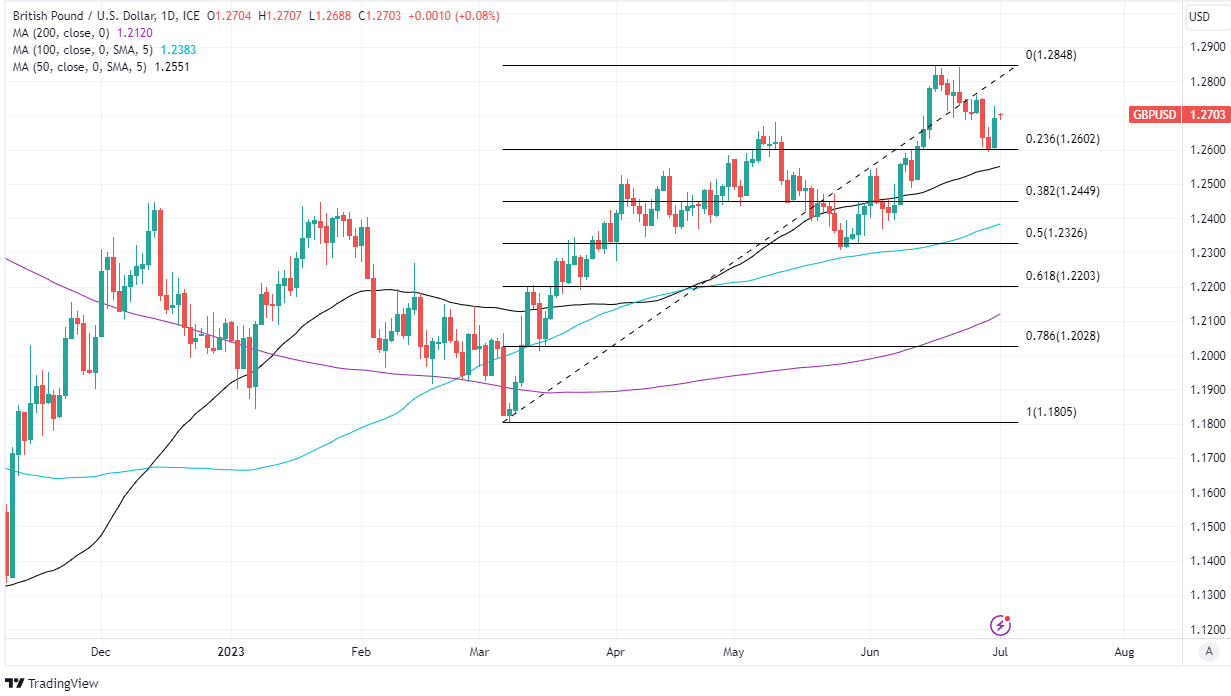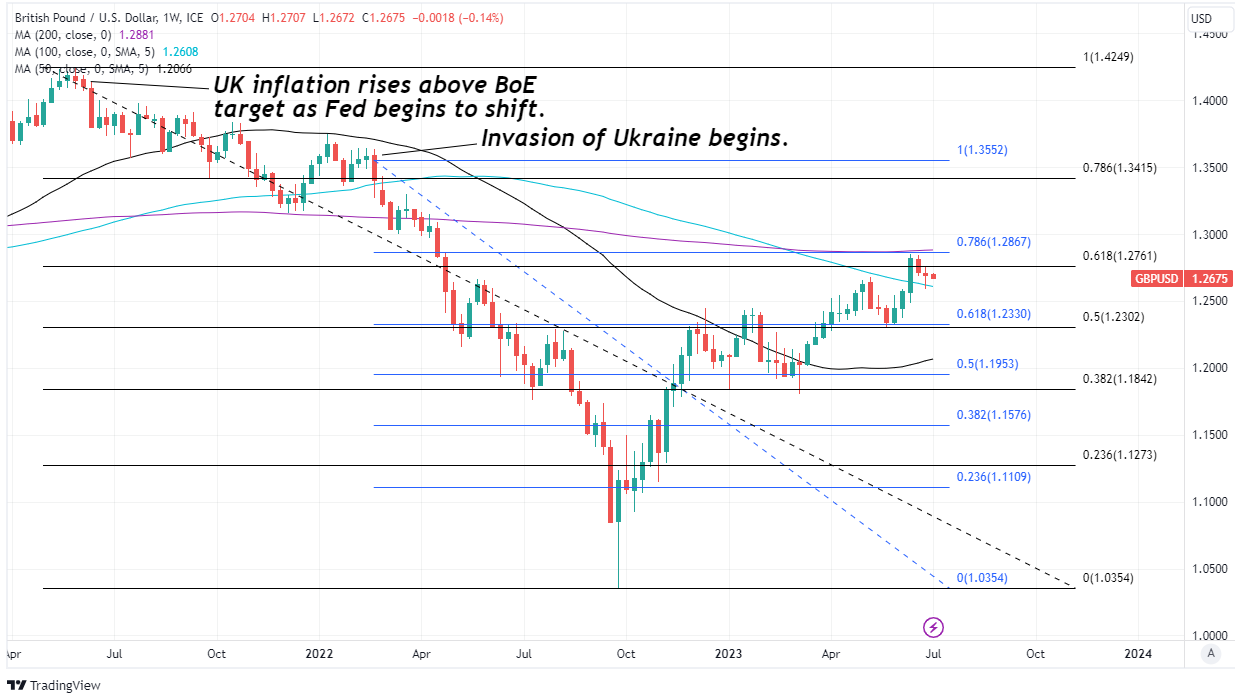GBPUSD Week Ahead Forecast: Chart Levels and U.S. Data in Focus
- GBP/USD supported around 1.26 short-term
- Technical resistance obstructing near 1.2850
- U.S. data, Fed pricing & BoE speech in focus

Image © Adobe Images
The Pound to Dollar exchange rate relinquished some of its June gains around the turn of the month but with technical support emerging around 1.26, it could be likely to consolidate between there and a nearby pocket of resistance around 1.2850 this week.
Sterling ended last week a fraction lower against half its G10 counterparts and a generally stronger U.S. Dollar but was an outperformer on Friday when another fall in the preferred inflation measure of the Federal Reserve (Fed) enabled the Pound to hold above the recently recovered 1.26 handle.
Friday's announced fall in the core PCE inflation rate for May surprised on the downside of economist forecasts and further eased the pressure on the Federal Reserve (Fed) to continue raising interest rates, dampening appetite for the U.S. Dollar and boosting other currencies along the way including Sterling.
"Incoming activity data continue to suggest the economy is growing at an above-trend pace. This is likely to keep pressure on inflation given limited spare capacity," says Tom Kenny, a senior economist at ANZ.
"Labour market data will be in focus this week. The Fed will be looking for an easing in Nonfarm Payrolls and the job openings to unemployment ratio," he adds.
Above: Fibonacci retracements of March rally highlight possible areas of technical support for Pound to Dollar rate. Click image for closer inspection.
Live GBP/EUR Money Transfer Exchange Rate Checker | ||
Live Market Rate: | get quick quote | |
Corpay: | ||
Banks: Median Low | ||
Banks: Median High | ||
These data are based on the spread surveyed in a recent survey conducted for Pound Sterling Live by The Money Cloud. | ||
Financial market pricing still implies a high probability of the Fed's interest rate being raised one further time in the months ahead, taking it up to between 5.25% and 5.5%.
However, that implied expectation is likely to be sensitive to the details and implications of important U.S. economic data due out this week including the monthly Job Openings and Labour Force Turnover Survey for May on Thursday, and the June non-farm payrolls report on Friday.
Meanwhile, and after the Bureau of Economic Analysis upgraded its earlier estimate of first-quarter GDP on Thursday, this week's Institute of Supply Management (ISM) surveys of activity in the manufacturing and services industries in June might also be relevant for the Dollar when out on Tuesday and Thursday.
The Pound to Dollar rate might benefit if either these or Wednesday's release of minutes from last month's Fed meeting pushes the prospect of additional increases in the Fed Funds rate further from view but Sterling is also likely to be responsive to the remarks of Bank of England Governor Andrew Bailey on Friday.
"Over coming months we expect the UK activity data to weaken further, particularly household spending. There is still a large share of ultra-low fixed rate mortgages scheduled to roll off over the coming year or so to much higher variable or fixed rates," writes Joseph Capurso, head of international economics at Commonwealth Bank of Australia, in a Monday research briefing.
Above: Quantitative model estimates of ranges for this week. Source Pound Sterling Live.
Live GBP/EUR Money Transfer Exchange Rate Checker | ||
Live Market Rate: | get quick quote | |
Corpay: | ||
Banks: Median Low | ||
Banks: Median High | ||
These data are based on the spread surveyed in a recent survey conducted for Pound Sterling Live by The Money Cloud. | ||
"The resulting substantial rise in household mortgage repayments will weigh on spending. There is downside support for GBP/USD at 1.2378 (100 day moving average), though is unlikely to be reached this week," he adds.
There are no important economic figures due for release in the UK this week but BoE Governor Bailey is scheduled to participate in a panel discussion at the Economic Meetings of Aix-En-Provence on Friday and the risk is of his remarks having a dampening effect on appetite for Sterling.
The governor already indicated in a panel discussion at the European Central Bank Forum on Central Banking last week that financial markets might be mistaken in expecting interest rates to rise much further as a result of the recent increase in wage growth and rebound of core inflation announced in the UK last month.
"The cumulative data, though particularly on the labour market and on the inflation release we had - which to us showed clear signs of persistence - caused us to conclude that we had to make really quite a strong move at that point," the governor said when asked about last week's decision in a panel discussion with other central bank heads.
"My own view on that was that if we're really of the view that we were going to do 25 and then we were really sort of baked in to do another 25 based on the evidence that we had seen, then it was better to do the 50 and then, as Christine said, be evidence-driven so we will wait for the next set of evidence," he added.
Above: Fibonacci retracements of various downtrends indicate possible areas of technical resistance for Pound to Dollar rate. Selected moving averages denote possible support and/or resistance. Click image for closer inspection.


